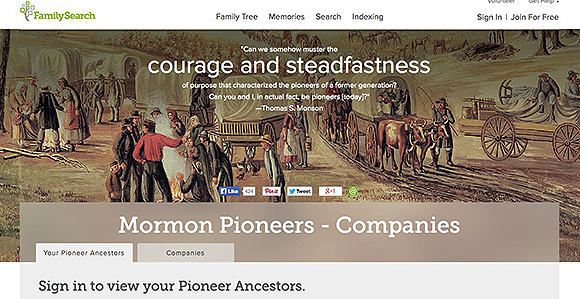New Site Makes It Easier to Find Your Pioneer Ancestors
Contributed By R. Scott Lloyd, Church News staff writer

The FamilySearch Internet genealogy service and the Mormon Pioneer Overland Travel database are now being offered on a single website that greatly facilitates learning about pioneer ancestry.
The Mormon Pioneer Overland Travel Database website and the FamilySearch Internet genealogy service each have long been a boon to people looking for information about their Mormon pioneer ancestry.
The two resources provided by separate departments of the Church now are being offered in a collaborative effort, announced July 22 by the Church Public Affairs Department.
Initiated more than 30 years ago and steadily developed since then, the Overland Travel Database today is widely regarded as the most complete listing of Mormon pioneers who traveled to Utah between the 1846–47 exodus of Latter-day Saints from Nauvoo, Illinois, and the coming of the railroad to Utah in 1869.
It contains more than 60,000 emigrant names and indexes and more than 350 known emigrating companies, providing access to information collected from rosters, journals, letters, and other primary sources.
FamilySearch, operated by the Church’s Family History Department, is the world’s premiere online genealogical service, offering access to records, resources, and services free to the general public.
This summer, just at the height of the July 24 Pioneer Day celebrations, the two departments are connecting the two resources by launching a new site, maintained by FamilySearch, which will provide access to both programs.
By going to the new site at familysearch.org/campaign/pioneers#/, users can have overland travel lists compared with their family trees on FamilySearch. This will provide the user with links and information from both sites.
The collaboration gives a way to draw on advantages from both resources: the Overland Travel site does not show family relationships, but that information can be provided by FamilySearch, showing a user whether he or she is connected to other pioneer families in the companies. And access to the Overland Travel database will provide FamilySearch users with a more personal experience by connecting them to letters, journals, and other documents pertaining to their ancestors.
Those registered can sign in with their FamilySearch login. The site will then automatically cross reference what is already in the registered user’s FamilySearch account and check it against the Overland Travel database, pulling up any other relationships the user may have had in other pioneer companies. From there, primary sources and references can be searched to learn what an ancestor might have experienced along the pioneer trail.
For example, a Church News writer logged on to the new site with his FamilySearch username and password. He was amazed when he was immediately met with a list of 11 of his Mormon pioneer ancestors, culled from his family tree that had previously been entered on FamilySearch.
Each of those 11 names was accompanied by the name of the pioneer company with which that ancestor crossed the plains to Utah; eight pioneer companies were represented among the 11 ancestors.
Each pioneer company name was linked to content on the Overland Travel database. With a click of his computer mouse, he found company information, departure and arrival dates, documentation sources, number of travelers in the company, and a summary of the trail experience taken from the documents listed.
The writer also found he could click on links to lists of the individuals traveling in the company, making it possible for him to compare notes with other descendants whose ancestors traveled in that company.
Also available were ship passenger or manifest lists giving names of the passengers who sailed with his ancestors from the British Isles or Scandinavia, where they had received the gospel. These were taken from the Mormon Immigration Index, published in 2000, and the Mormon Migration website found at mormonmigration.lib.byu.edu, which was created to supersede the CD on which the index was originally published.
